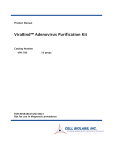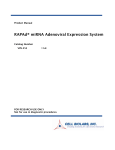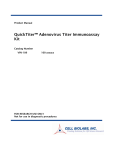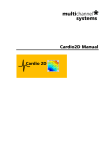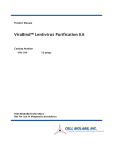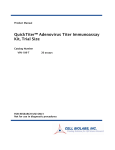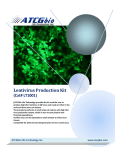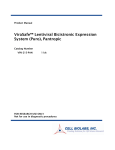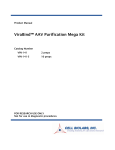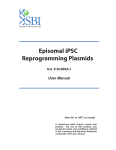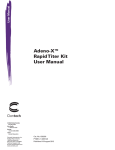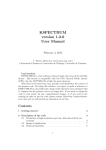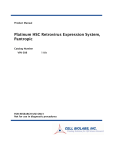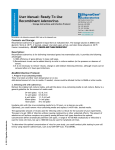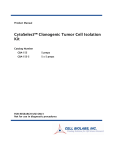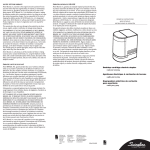Download Rapid RCA Assay Kit - Cell Biolabs, Inc.
Transcript
Product Manual Rapid RCA Assay Kit Catalog Number VPK-111 30 assays VPK-111-5 5 x 30 assays FOR RESEARCH USE ONLY Not for use in diagnostic procedures Introduction Recombinant adenoviruses have tremendous potential in both research and therapeutic applications. There are numerous advantages they provide when introducing genetic material into host cells. The permissive host cell range is very wide. The virus has been used to infect many mammalian cell types (both replicative and non-replicative) for high expression of the recombinant protein. Recombinant adenoviruses are especially useful for gene transfer and protein expression in cell lines that have low transfection efficiency with liposome. After entering cells, the virus remains epichromosomal (i.e. does not integrate into the host chromosome so does not activate or inactivate host genes). Recently, recombinant adenoviruses have been used to deliver RNAi into cells. HEK 293 cells or their variants are used as host cells for viral amplification. Recombinant adenoviruses can be grown at high titer (1010 VP (viral particles)/mL, which can be concentrated up to 1013 VP/mL) and purified by Cell Biolabs ViraBind™ Adenoviral Purification Kit or traditional CsCl ultracentrifugation. During adenovirus vector production, particles may be generated which are replication competent. The probability of producing replication competent adenovirus (RCA), although low, increases with each successive amplification. RCA is thought to be produced via homologous recombination. Traditionally, RCA is measured in permissive cells by a plaque-forming unit assay (PFU) that scores the number of viral plaques as a function of dilution. These methods are time-consuming (10-14 days), require a long infection period, and suffer from a high degree of inter-assay variability and are affected by virus-cell interactions. Cell Biolabs’ Rapid RCA Assay Kit utilizes an antibody against adenovirus hexon proteins to visualize infected cells by immunocytochemistry staining, the kit antibody against hexon protein recognizes all serotypes of adenovirus. The hexon proteins are the largest and most abundant of the structural proteins in the adenovirus capsid, and they are distributed symmetrically to form capsid facets. Cell Biolabs Rapid RCA Assay Kit provides a quick and complete system to measure the titer of replication-competent virus in your viral prep, in contrast to the 10-day infection of a classical plaque assay, the kit only requires 2-day infection. The kit provides sufficient reagents for up to 30 tests in 6well culture plates. 2 Assay Principle Related Products 1. VPK-106: QuickTiter™ Adenovirus Quantitation Kit 2. VPK-109: QuickTiter™ Adenovirus Titer Immunoassay Kit 3. VPK-110: QuickTiter™ Adenovirus Titer ELISA Kit 4. VPK-252: RAPAd® CMV Adenoviral Expression System 5. VPK-099: ViraBind™ Adenovirus Miniprep Kit 6. VPK-100: ViraBind™ Adenovirus Purification Kit 7. AD-100: 293AD Cell Line 8. AD-200: ViraDuctin™ Adenovirus Transduction Reagent 9. VPK-112: QuickTiter™ Lentivirus Quantitation Kit 10. VPK-120: QuickTiter™ Retrovirus Quantitation Kit Kit Components 1. Anti-Hexon Antibody (1000X) (Part No. 10901): One tube – 30 µL. 2. Secondary Antibody, HRP Conjugate (1000X) (Part No. 10902): One tube – 50 µL. 3. DAB Substrate (25X) (Part No. 10903): One tube – 1.5 mL. 4. Diluent (10X) (Part No. 10905): Three tubes – 1.5 mL each. 3 Materials Not Supplied 1. Recombinant adenovirus of interest 2. A549 cells and cell culture growth medium 3. Methanol 4. 1% BSA/PBS 5. H2O2 6. Light Microscope 7. (optional) Wild type adenovirus Storage Store all kit components at 4ºC until their expiration dates. Safety Considerations Remember that you will be working with samples containing infectious virus. Follow the recommended NIH guidelines for all materials containing BSL-2 organisms. Preparation of Reagents The table below is suggested for tests in 6-well plate. • 1X Anti-Hexon antibody solution: Prepare a 1X anti-hexon antibody solution by diluting the provided 1000X Anti-Hexon antibody stock 1:1000 in 1% BSA/PBS. Store the diluted solution on ice. • 1X Secondary antibody solution: Prepare a 1X Secondary antibody solution by diluting the provided 1000X stock 1:1000 in 1% BSA/PBS. Store the diluted solution on ice. • 1X DAB working solution: Prior to use, FRESHLY prepare a 1X DAB working solution. First dilute the provided 10X Diluent to 1X with ddH2O, and add H2O2 to a final concentration of 0.01%. Then dilute the 25X DAB stock to 1X with 1X Diluent/ H2O2 and use the 1X DAB working solution immediately. Note: When dilute 10X diluent, use ddH2O. precipitation. Reagents 6 tests 1000X Anti-hexon Antibody 6 1000X Secondary Antibody 6 25X DAB 240 μL Final Volume (Each Reagent) 6 mL Heavy metals in impure H2O will cause DAB 12 tests 12 μL 12 μL 480 μL 24 tests 24 μL 24 μL 960 µL 12 mL 24 mL Table 1. Preparation of Antibody and DAB solutions for use in a 6-well Plate. 4 Preparation of Adenoviral Samples Immediately before infection, dilute your adenovirus sample to 1 x 109 VPs/mL in culture medium. Prepare 2 mL for each viral sample. For example, if you have a viral prep of 1 X 1012 VPs/mL, add 20 µL into 2 mL of culture medium. Note: A wild type adenovirus, such as wild type Ad5, should be used as an assay positive control, and prepare serial dilutions of the wild type adenovirus in culture medium. Assay Protocol The instructions below are suggested for assays performed in 6-well plate. I. Virus Infection 1. Harvest fresh, healthy A549 cells and resuspend cells in culture medium at 2.5 x 105 cells/mL. Seed 2 mL in each well of a 6-well plate and incubate at 37ºC, 5% CO2 for 1 hr. 2. Dropwise add 0.5 mL of adenoviral sample (1 x 109 VPs/mL) to each well of the 6-well plate. To ensure accuracy, perform each sample in duplicate. Note: a positive control, such as wild type Ad5, should be performed simultaneously. 3. Incubate infected cells at 37ºC, 5% CO2 for 48 hrs. II. Immunostaining 1. Slowly remove medium from the wells by tilting the plate and aspirating from the edge, then fix infected A549 cells by gently adding 2 ml of cold methanol to each well of the 6-well assay plate. Incubate 20 minutes at -20ºC. 2. Gently wash the fixed cells three times with 1X PBS, five minutes each wash. 3. Block for 1 hr with 1% BSA in PBS at room temperature on an orbital shaker. 4. Add 1 mL of diluted 1X anti-Hexon antibody solution to each well and incubate for 1 hr at room temperature on an orbital shaker. 5. Gently wash the fixed cells three times with 1X PBS, five minutes each wash. 6. Add 1 mL of diluted 1X Secondary antibody solution (HRP-conjugated) to each well and incubate for 1 hr at room temperature on an orbital shaker. 7. Gently wash the fixed cells five times with 1X PBS, five minutes each wash. 8. Add 1 mL of freshly diluted 1X DAB working solution to each well and incubate for 15-30 minutes at room temperature on an orbital shaker. 9. Aspirate DAB, wash once with 1X PBS and add 2 mL of 1X PBS to each well. 10. Count positive stained cells (brown) for at least ten separate fields per well using a light microscope and 10X objective. 11. Calculate the average number of positive cells per field and RCA. 5 Example of Results The following figures demonstrate typical RCA assay results. One should use the data below for reference only. This data should not be used to interpret actual results. Figure 1: Rapid RCA Assay. Serial 10-fold dilutions of wild type Ad5 (2.0 x 1012 VPs/mL) were used to infect A549 cells in 6-well plate for 48 hrs. Anti-Hexon immunostaining was performed as described in Assay Instructions. Calculation of Replication Competent Adenovirus 1. Randomly count at least 10 fields. Calculate the average number of positive cells per field. 2. Determine the number of fields per well. For most microscopes, a standard 10X objective lens with 10X eyepiece lens has a field diameter (D) of 1.8 mm, then: Area per field = 3.14 x (D/2)2 = 3.14 x 0.92 = 2.54 mm2 For a standard 6-well plate, the surface area is 9.5 cm2/well, therefore: Fields/each well of 6-well plate = 9.5 cm2/2.54 mm2 = 9.5 cm2/2.54 x 10-2 cm2 = 374 Note: If you are not sure about the field diameter of the 10X objective lens you are using or you are using objective lenses other than 10X, the field diameter can be determined by aligning with the grids of hemacytometer (Figure 3), or referring table 2. 6 Figure 3. Hemacytometer Grid Dimensions. Eyepiece Lenses Objective Lenses (10X) Total Magnification 4X 40X 10X 100X 20X 200X Table 2. Field sizes of objective lenses. Fields/Well (6-well Plate) Field Diameter 5 mm 1.8 mm 0.9 mm 48 374 1494 3. Calculate RCA (Replication-competent Adenovirus/VP) For wild type Ad5: RCA = (average positive cells/field) x (374 fields/well) x (dilution factor) Total VPs in 0.5 mL viral sample For recombinant adenovirus: RCA = (average positive cells/field) x (374 fields/well) 0.5 x 109 VPs in 0.5 mL viral sample Calculation Examples: Sample #1: wild type Ad5 A serial of 10-fold dilutions of the wild type Ad5 (2.0 x 1012 VP/mL) were made and RCAs were determined in a 6-well plate as described in assay instruction. At 1/107 dilution, ten fields were counted and the average positive cells/field is 40 under a standard 10X objective, therefore: RCA = (average positive cells/field) x (374 fields/well) x (dilution factor) Total VPs in 0.5 mL viral sample RCA = (40/field) x (374 fields/well) x (107) = 1.5 x 1011 RCA in 1012 VP or 15 RCAs in 100VP 1.0 x 1012 VP 7 Sample #2: Recombinant Ad-β gal Ad-β gal viral stock (1.2 x 1012 VPs/mL) was diluted to 1 x 109 VPs/mL and its RCA was determined in a 6-well plate as described in assay instruction. Ten fields were counted and no positive stained cells are visible under a standard 10X objective, therefore: RCA = (average positive cells/field) x (374 fields/well) 0.5 x 109 VPs in 0.5 mL viral sample RCA = (0/filed) x (374 fields/well) = 0 RCA in 0.5 x 109 VPs or <1 RCA in 0.5 x 109 VPs 0.5 x 109 VPs Note: If there is no positive stained cell in your viral sample, it indicates that the titer of RCA is <1 RCA in 0.5 x 109 VPs in your viral prep. For detail on adenovirus RCA safety, please follow NIH guidelines. References 1. Bewig, B., and W. E. Schmidt (2000) Accelerated titering of adenoviruses. BioTechniques 28:870873. Recent Product Citation Dubuisson, O. et al. (2015). Accurate identification of neutralizing antibodies to adenovirus Ad36, a putative contributor of obesity in humans. J Diabetes Complications. 29: 83-87. Warranty These products are warranted to perform as described in their labeling and in Cell Biolabs literature when used in accordance with their instructions. THERE ARE NO WARRANTIES THAT EXTEND BEYOND THIS EXPRESSED WARRANTY AND CELL BIOLABS DISCLAIMS ANY IMPLIED WARRANTY OF MERCHANTABILITY OR WARRANTY OF FITNESS FOR PARTICULAR PURPOSE. CELL BIOLABS’ sole obligation and purchaser’s exclusive remedy for breach of this warranty shall be, at the option of CELL BIOLABS, to repair or replace the products. In no event shall CELL BIOLABS be liable for any proximate, incidental or consequential damages in connection with the products. Contact Information Cell Biolabs, Inc. 7758 Arjons Drive San Diego, CA 92126 Worldwide: +1 858-271-6500 USA Toll-Free: 1-888-CBL-0505 E-mail: [email protected] www.cellbiolabs.com 2004-2015: Cell Biolabs, Inc. - All rights reserved. No part of these works may be reproduced in any form without permissions in writing. 8








